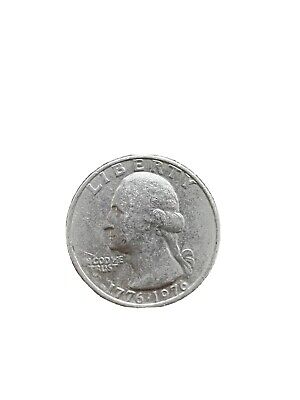The 1976 Bicentennial Quarter is unique, celebrating 200 years since the Declaration of Independence, and market value has spiked.
1776-1976 Bicentennial Quarter Value Chart
The value of a 1776-1976 Bicentennial Quarter varies depending on its condition.
| Condition | Estimated Value Range |
|---|---|
| Good | $0.25 – $0.50 |
| Fine | $0.50 – $1.00 |
| Extra Fine (XF45) | $1.00 – $1.50 |
| About Uncirculated (AU) | $1.50 – $3.00 |
| Brilliant Uncirculated (BU) | $3.00 – $5.00 |
| MS66 | $15.00 – $25.00 |
1776-1976 Bicentennial Quarter Design and Composition
The reverse features a unique design created by Jack L. Ahr, depicting a Colonial drummer boy facing left and a torch encircled by 13 stars. The coin also features a reeded edge with 119 reeds.

This quarter is clad with 91.67% copper and 8.33% nickel. It has a standard diameter of 24.3 millimeters and a weight of 5.67 grams, consistent with quarters minted during this era.
Rare Issues and Error Coins
Some 1976 Bicentennial Quarters are more valuable due to errors or unique features. Known errors include doubled die obverses and reverse errors that fetch $150 to $500 or more.
Special Releases: Proof Coins and Special Mint Sets
The U.S. Mint produced proof coins and unique mint sets to commemorate the bicentennial that were struck with more detail and a mirror-like finish. The mint issued proofs in both clad and 40% silver varieties. The 40% silver silver proof coins are more valuable than their copper-nickel counterparts.
Identifying a Valuable 1776-1976 Washington Bicentennial Quarter
To identify a valuable Bicentennial Quarter, collectors should look for coins in mint state condition with minimal wear. Error coins with doubled dies or off-center strikes should be authenticated for their rarity. Proof coins, particularly those with silver content, are generally more desirable.
Varieties of 1976 Washington Bicentennial Quarters
Regular Proof: Standard composition proof.
Clad Circulation Strike: Made primarily for everyday use, these are the most common and less valuable unless in exceptional condition or with errors.
Silver-Clad Proof: These coins contain 40% silver, are part of special mint sets, and are more valuable due to their metal content and limited mintage.